

Investigations had concentrated on the chemical properties of the limesands, but once in use it became apparent that the physical properties of the sands created difficulties in the blast furnace. This caused a reduction in demand, and by late 1973 only one train per week was running. Three years later this was further reduced, with only occasional trips run. Storm damage to the outloader at Proper Bay in 1989 resulted in the cessation of all services. The last locomotive left in 1993, and the track was removed in 2000/2001.
| Type | Details | |
| G8b |
DE01, DE02.
Built 1956 by Clyde Engineering for BHP Whyalla (3'6" gauge), used initially at Iron Knob. Converted to standard gauge and transferred to Port Lincoln in Jul 1968 (DE02) and Aug 1968 (DE01), replacing DE08. DE01 returned to Whyalla in Oct 1975, while DE02 remained at Port Lincoln until 1993. |
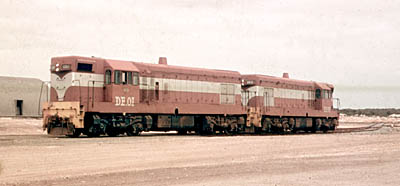
|
|
DE01 and DE02 shunting at BHP's Proper Bay terminal, Port Lincoln, 31 Aug 1970.
Photo: Peter Knife |
||
| G12b |
DE08.
Built 1968 by Clyde Engineering for the Coffin Bay line. Used on narrow gauge at Whyalla from November 1965, it was transferred to Port Lincoln on 12 Jan 1966. It was used initially on ballast trains, and later that year commenced lime sands haulage. DE08 was transferred back to Whyalla on 8 Nov 1968.
DE09 was also built for the Coffin Bay line, but never ran there, being used at Whyalla from new. |
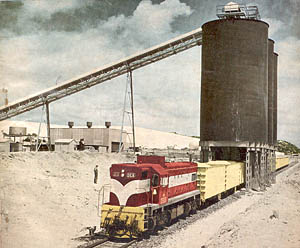
|
|
DE08 and train under the loaders at Coffin Bay, 1966 (hand coloured photo).
Reproduced courtesy 'Railway Transportation' magazine |
||
| Type | Details | |
|
Lime sand hoppers |
31 vehicles: 1-31.
Built by Comeng, Bassendean (WA), delivered between March and November 1966. 76 tons capacity, 100 tons gross. Vehicles 2 and 10 used as weed spray wagons, with pump mounted on no.10 and hoses and spray beams on both. |
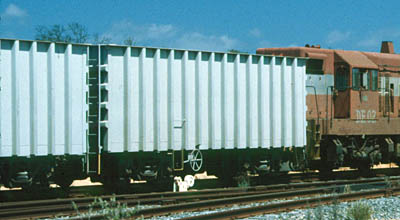
|
|
Sand hoppers being shunted, Proper Bay, 25 Feb 1986.
Photo: John Dennis |
||
|
Ballast hoppers |
15 vehicles: BAS 507, 520, 559, 570, 571, 577, 583, 596, 605, 606, 607, 609, 615, 621, 627.
Ex Commonwealth Railways. Originally built 1915-16 by WA State Iron Works (507, 520 and 559) and by Gray Bros (others). Sold to BHP 23 Aug 1965. 605 donated to EPRPS Museum by Dean Lukin, 615 donated to National Railway Museum by Nic Doncaster. |
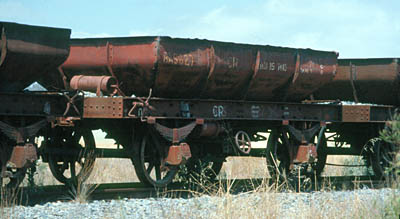
|
|
BAS 627 at Proper Bay, 25 Feb 1986
Photo: Peter Knife |
||
|
Ballast plough |
1 vehicle: BPS 210.
Ex Commonwealth Railways. Originally built 1914 by Goninan as TSA water tank, converted to ballast plough 1916. Sold to BHP 23 Aug 1965. Donated to EPRPS Museum by Dean Lukin. |
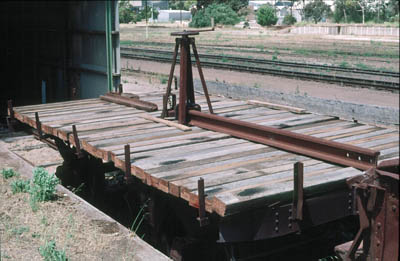

|
|
Above right: Ballast plough BPS 210 at the EPRPS Museum, Feb 2002. Note the new decking installed by museum volunteers.
Right: Plough and undergear of BPS210. Photos: John Dennis |
||
|
Open wagon |
1 vehicle: BS 442.
Ex Commonwealth Railways. Originally built 1915 by Gray Bros. Sold to BHP 23 Aug 1965. Donated to EPRPS Museum by Dean Lukin. |
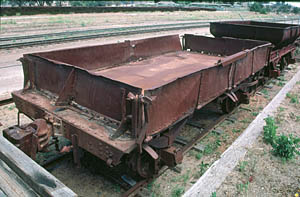
|
|
BS 442 at the EPRPS Museum, Feb 2002.
Photo: John Dennis |
||
|
Flat wagon |
13 vehicles.
These were coal hopper wagons ex Muswellbrook Colliery (6 vehicles) and Borehole Colliery (7 vehicles) in NSW, with their hopper bodies removed. They were used during construction of the line. The only vehicle numbers which have been identified are 393, 412, 443 and 3470 (from the photograph). |
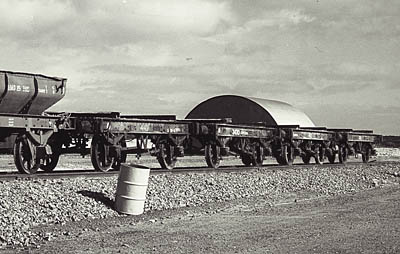
|
|
Four of the ex-NSW hopper underframes at Proper Bay in 1976.
Photo: Alex Grunbach |
||
